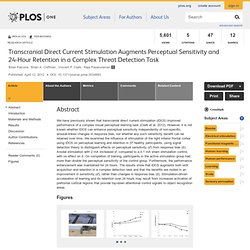

Foc.us headset zaps your brain to improve your game. What would you do if you wanted to improve your video game skills?

Practice more often? Study game maps? Maybe get some tips from pro gamers? But why do any of that when you can just hook some electrodes to your scalp and run an electric current through your cranium? That's what Focus Labs is offering with the foc.us headset, which it claims will improve a gamer's abilities by stimulating specific areas of the brain with a low electric current. It may sound like science fiction, but according to the developers, the headset's mind-boosting abilities come from transcranial Direct Current Stimulation (tDCS), a controversial practice that has seen a minor resurgence in recent years. In the case of the foc.us headset though, the electric current supposedly heightens the wearer's brain power to give them an edge in competitive video games. The headset itself is built around a Bluetooth low energy system chip from Texas Instruments connected to an array of four electrodes. Transcranial Direct Current Stimulation Augments Perceptual Sensitivity and 24-Hour Retention in a Complex Threat Detection Task.
We have previously shown that transcranial direct current stimulation (tDCS) improved performance of a complex visual perceptual learning task (Clark et al. 2012).

However, it is not known whether tDCS can enhance perceptual sensitivity independently of non-specific, arousal-linked changes in response bias, nor whether any such sensitivity benefit can be retained over time. We examined the influence of stimulation of the right inferior frontal cortex using tDCS on perceptual learning and retention in 37 healthy participants, using signal detection theory to distinguish effects on perceptual sensitivity (d′) from response bias (ß). Anodal stimulation with 2 mA increased d′, compared to a 0.1 mA sham stimulation control, with no effect on ß. On completion of training, participants in the active stimulation group had more than double the perceptual sensitivity of the control group.
Furthermore, the performance enhancement was maintained for 24 hours. Figures Introduction Ethics Statement. Neuroscience: Brain buzz. Trouble With Math? Maybe You Should Get Your Brain Zapped. GoFlow - World's First tDCS Kit. Foc.us headset zaps your brain to improve your game. Neuroscience: Brain buzz. About TMS. What is Transcranial Magnetic Stimulation (TMS) ?

Transcranial Magnetic Stimulation (TMS) involves a series of short magnetic pulses directed to the brain to stimulate nerve cells. Since 1985, research has been conducted with TMS to understand and treat a number of neurological conditions (i.e. migraines, Parkinson’s disease, tinnitus) and psychiatric conditions (i.e. depression). Most recently, researchers have been focusing on the use of TMS as a treatment option for major depressive disorder. The magnetic energy released from the TMS device passes through the skull easily. The energy is directed to access brain structures that thought to control mood (limbic system). How is it done? What risks are associated with TMS? Other possible side effects are:
Trouble With Math? Maybe You Should Get Your Brain Zapped. Boost Your Brain’s Power With a 9-Volt Battery and Some Wet Sponges. It seems, with the help of a 9-volt battery, wire, crocodile clips, and wet sponges, you can increase your brain’s performance and, more importantly, return your brain to its younger, more malleable and learning-receptive state.

The technique, which is lumbered with the fantastic and slightly terrifying name of transcranial direct-current stimulation (tDCS), is similar to deep brain stimulation (DBS), but it doesn’t involve complex neurosurgery. TCDS runs a very small current — just 2 milliamps — into brain tissue just beneath your scalp; it’s non-invasive, and seemingly quite safe.
By pumping electrons into the brain, neurons move a few millivolts towards ‘depolarization’, which makes them more sensitive, and thus reducing the time it takes signals to travel across your nervous system. More importantly, though, this technique increases the plasticity of brain tissue, leaving it in a kind of ‘wet clay’ state after the electrical current has been removed. Read more at Nature.